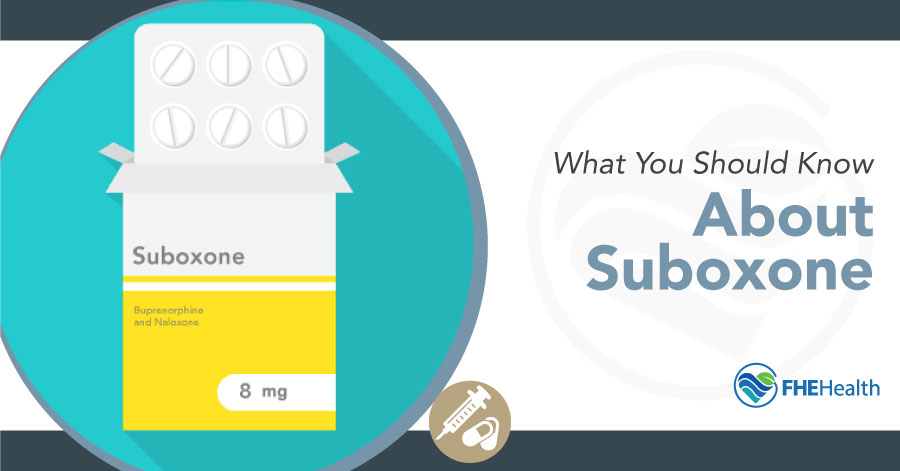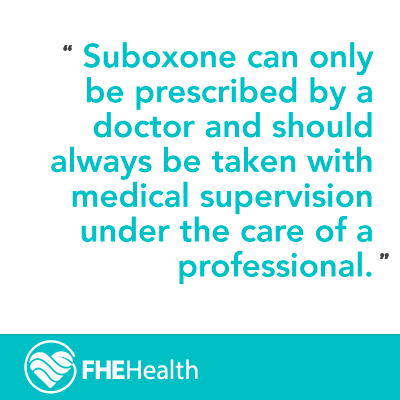
Suboxone is the brand name of a prescription medication containing buprenorphine (an opioid) and naloxone (an opiate blocker). It is frequently prescribed during detoxification from opiates and sometimes as long-term maintenance. Suboxone is prescribed by a doctor and comes in the form of a thin dissolvable strip or pill taken orally.
The drug works by weaning a patient off of opiates in a controlled, monitored manner in order to minimize the symptoms of withdrawal. As a mild-acting opioid, Suboxone has painkilling properties.
Patients cannot take any other opioids when on Suboxone. Much like the nasal spray Narcan, which is used as an emergency treatment for opioid overdose, the active ingredient naloxone in Suboxone reverses the effects of an opioid.
Suboxone can only be prescribed by a doctor and should always be taken with medical supervision under the care of a professional. Because of its mildly addictive properties, Suboxone may be abused and requires the medical supervision of professionals.
How Is Suboxone Distributed?
Suboxone is distributed as individually packaged strips. These usually come in prescriptions tailored for the length of the detoxification process. (Learn more about the use of Suboxone in Medication Assisted Treatment (MAT).)
In the case of long-term Suboxone maintenance, Suboxone can be distributed in weekly or monthly amounts, in prepackaged strips to be taken on a daily basis. Someone who is addicted to opiates has likely found that once they stop taking opiates after a period of daily use, withdrawal symptoms quickly ensue. For example, if someone uses a gram of heroin regularly and then suddenly stops cold turkey, they will invariably experience flu-like symptoms such as vomiting, shivering, sweating, etc…
The medical need for Suboxone treatment is determined by a doctor. It is effective for helping to keep severe withdrawal symptoms at bay.
Buprenorphine is one of the two active ingredients in Suboxone and is a mild opioid, which can produce similar effects to that of opiates such as oxycodone or heroin when taken in extreme amounts. The active amount of buprenorphine is small relative to the amount that someone would be taking to get high, and therefore simply reduces the feelings of sickness that come from abruptly halting opiate use.
Subutex, often misunderstood to be the same as Suboxone, also contains buprenorphine but is missing a key ingredient: naloxone. Naloxone is an opiate agonist. It is used in Narcan nasal spray, known for its ability to bring someone back from the brink of death after an opiate overdose. Naloxone can reverse the effects of opiates and is the second active ingredient in Suboxone.
Once an individual has taken Suboxone, its ingredients serve to block the effects of any opiates that one might ingest, accidentally or intentionally. An individual cannot take Suboxone while using an opiate without entering into a state of precipitated withdrawal. This means that all the flu-like symptoms just mentioned will occur instantly.
Medical providers typically recommend that someone who is detoxing should receive their first prescribed dose of Suboxone 24 hours after their last use of opiates. Suboxone treatment involves the use of Suboxone to wean someone off of opiates.
In the world of drug treatment, it is not uncommon to see someone make attempt after attempt at lasting sobriety and end in failure, overdose, and, sadly, death. This means that patients with severe opiate addiction may have the option of long-term Suboxone “maintenance.” It involves a highly supervised, daily dose of Suboxone that can help them function on a daily basis without resorting to heroin or another opiate drug of choice. The goal of this treatment is to help recovering individuals maintain long-term, permanent abstinence. For many people, too, six months of Suboxone can mean six months without overdosing and more peace of mind for their families and loved ones as the patient progresses in their recovery.
The opioid buprenorphine (in Suboxone) can still produce a similar effect to that of stronger opiates if taken after a period of abstinence. Buprenorphine, like all opioids, can be physically addictive and come with a withdrawal period. Suboxone withdrawal is much different from heroin, however, because it is under the close supervision of a medical professional.
Suboxone is administered in strips in increments of 2mg up to 12mg at a time. A patient taking Suboxone would eventually be weaned off to progressively lower amounts until finally ready to stop altogether. Meanwhile, the daily amount taken is so small that the withdrawal symptoms are very manageable. It is not uncommon to be prescribed other non-narcotic support medications to help with the symptoms of this milder withdrawal, such as restlessness, fatigue, or nausea.
What Is a Suboxone Strip?
Sometimes referred to as Suboxone film, Suboxone strips have been approved since 2002 to treat opioid use disorder. The strips are administered under the tongue (sublingually). The goal of Suboxone strip treatment is to prevent withdrawal and intense cravings for opioids. While taking Suboxone strips, recovering individuals invariably find it easier to focus on other treatments such as their one-on-one therapy or peer group counseling.
Can You Abuse Suboxone Strips?
A Suboxone strip features the same active ingredients, buprenorphine and naloxone, as Suboxone pills; however, the strips are not as easy to abuse, which makes them preferable for many medical caregivers who want to minimize the risks for abuse wherever they can. The films aren’t as easy to abuse because they can’t be crushed and then snorted. Taking more than a prescribed dose would constitute an abuse as would taking the strip with any other addictive substances, including alcohol. Fortunately, the risk for Suboxone addiction is low, especially when compared to other, more dangerous (and deadly) opioids.
Additionally, Suboxone may simply not be recommended for all people recovering from an opioid addiction. For instance, Suboxone treatment is not recommended for patients who have severe liver problems or serious respiratory conditions such as asthma.
Is It Dangerous to Take Too Many Suboxone Strips?
Technically, yes, taking too much Suboxone can cause overdose. However, its use is typically carefully administered during detox. When taken as a form of long-term maintenance, it is possible to overdose on Suboxone, especially when taking another drug or alcohol with it. Additionally, some people may be at increased risk of Suboxone addiction because of a medical condition that can affect how the body processes the drug. For instance, people with reduced kidney or liver function are at increased risk for Suboxone overdose.
Can You Take Suboxone with Other Drugs?
The primary goal of Suboxone treatment is to ease the symptoms of opiate withdrawal. Because Suboxone contains an opioid, it is, in fact, possible to obtain a pleasant feeling not dissimilar to that of a stronger opiate/opioid when taking Suboxone. The dose, however, is usually such a small amount relative to what someone in active addiction would be taking, that it simply prevents one from feeling withdrawal without actually inducing a high. Suboxone is a Schedule III narcotic drug and thus can only be dispensed by a doctor who is certified to prescribe it. Typically, quality treatment centers will have at least on psychiatrist on hand who is qualified to oversee this prescribing.
Dangers of Suboxone
While Suboxone has saved thousands of lives from overdose and severe opiate addiction, it is still somewhat controversial in the recovery community. The fact that it keeps people off worse drugs, alleviates withdrawal symptoms, and can prevent overdose make it a valuable tool in the fight against the opiate epidemic.
Even so, while it is less addictive than other opiates, it is not without some risk of dependence and addiction. Some people may take Suboxone for years at a time and then struggle to get off of it because of the withdrawal symptoms that can occur. Tapering off Suboxone slowly can be difficult, depending on the person.
Many people in recovery believe that using Suboxone is simply trading one drug for another. They do not view the use of Suboxone as true sobriety and may consider it an obstacle to recovery. Many people believe that a long-term residential treatment program with complete sobriety is the only way to achieve true recovery. They insist that a treatment program helps change a person’s mind, body and spirit, which is necessary for a life transformation away from drugs. Still, it is hard to argue against Suboxone for people who have tried treatment multiple times and cannot stay sober. The fact that people can take Suboxone, avoid overdosing, and avoid using street drugs seems like a step in the right direction.
If you are considering Suboxone for yourself or a loved one, reach out to FHE Health. Suboxone has helped many people successfully achieve recovery. Our compassionate counselors are available 24/7 to answer any questions.







